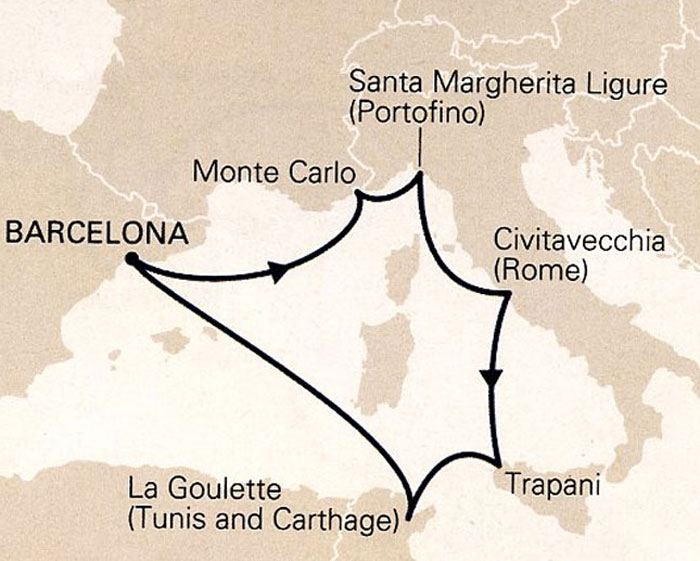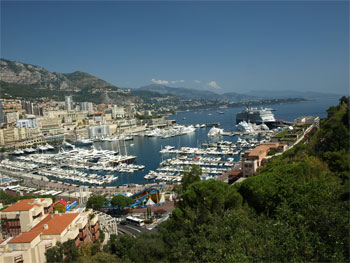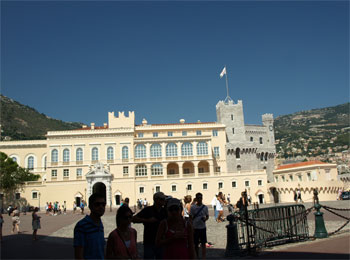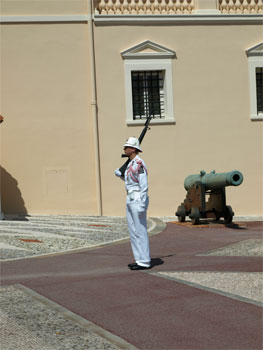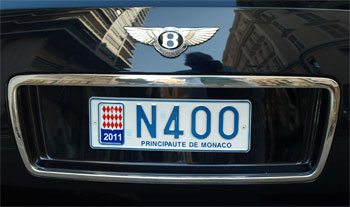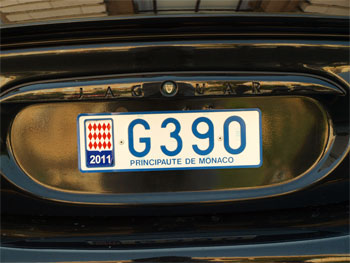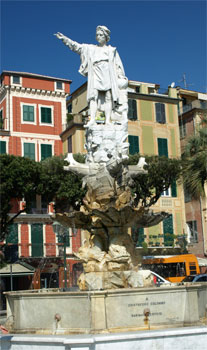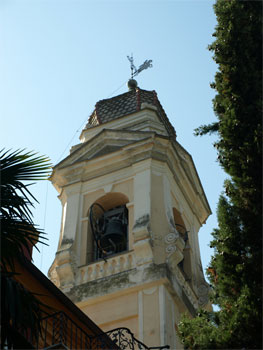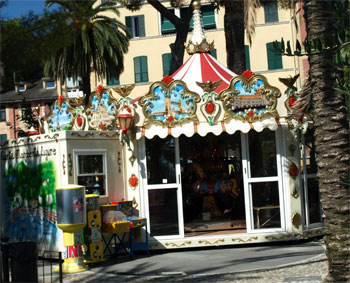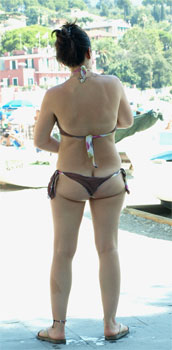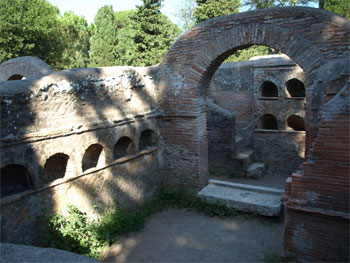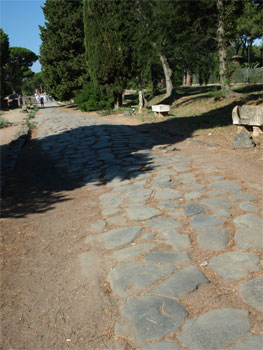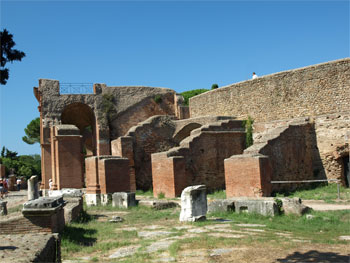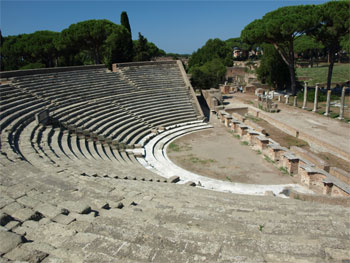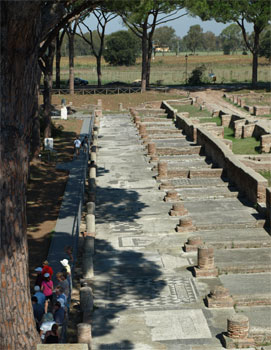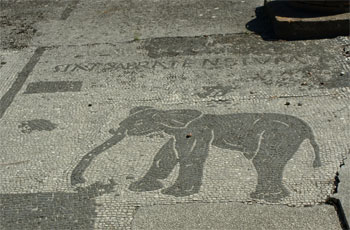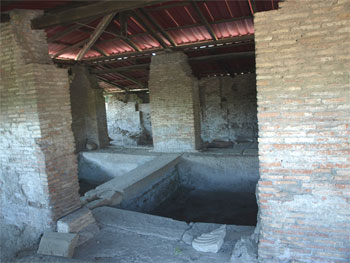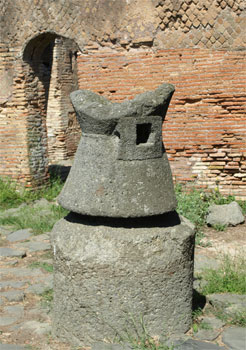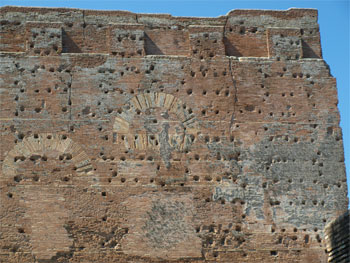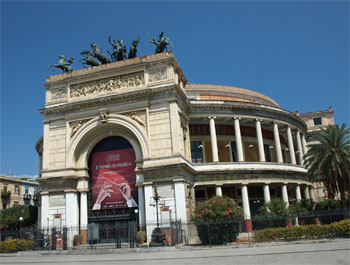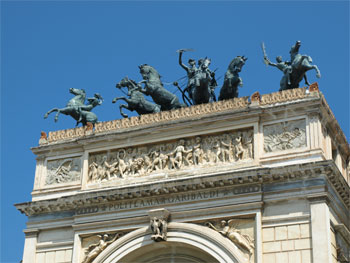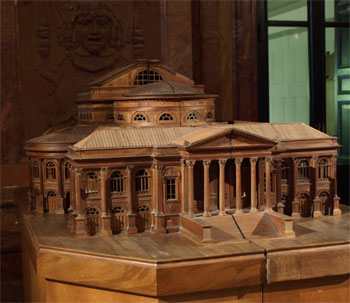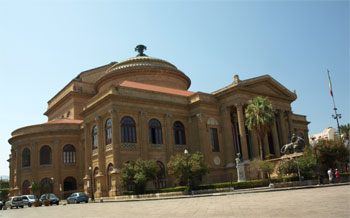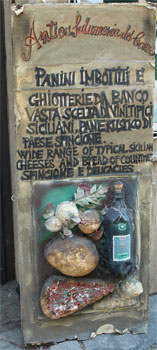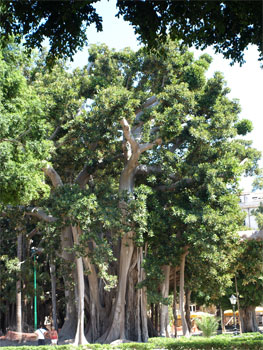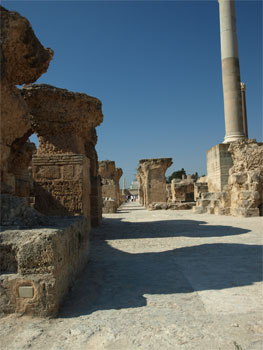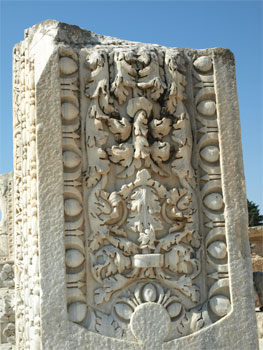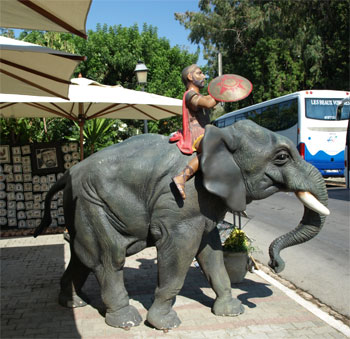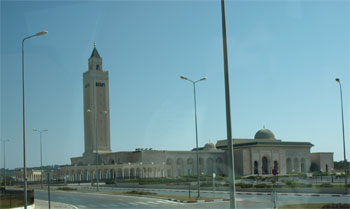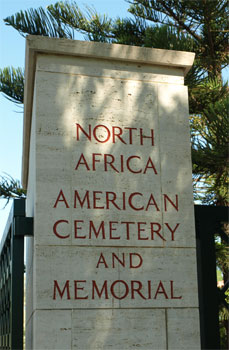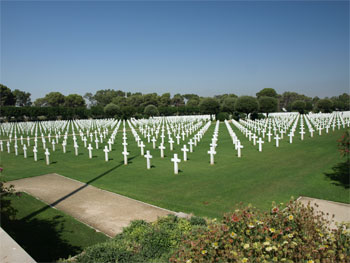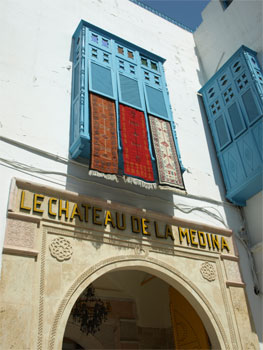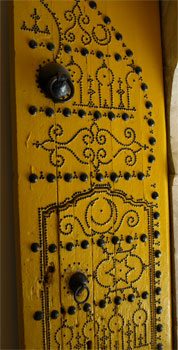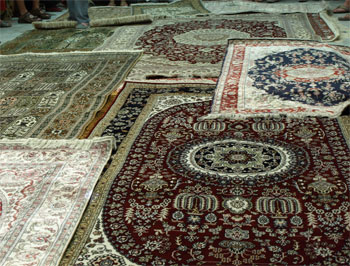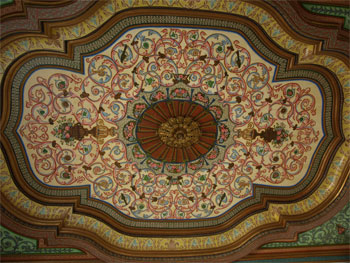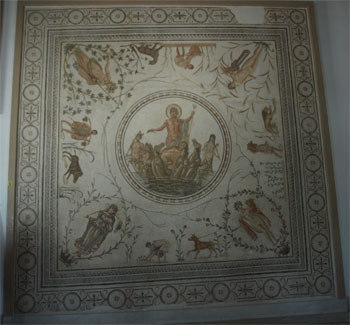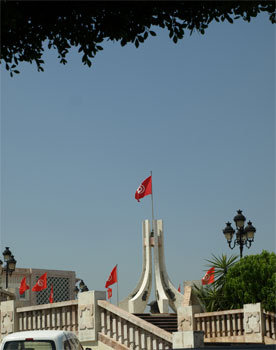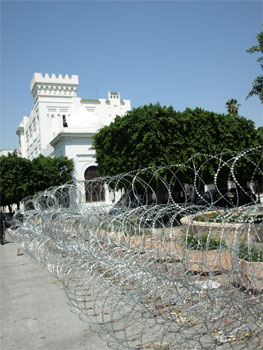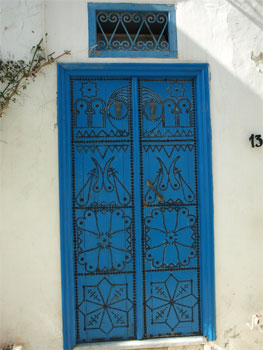Holland America's Mediterranean Glamour Cruise
|
Mon., 8/22/11 - Monte Carlo, Monaco
We docked at 11 AM and looked out at the marina filled with VERY expensive, LARGE yachts and high-rise buildings covering the hilly one square mile of the country. First we headed up the hill toward the palace. It was a nice walk up the old fortress on brick paths and steps and neat gardens with lots of shade trees. Since it was already 95° (but only 50% humidity) the shade was very welcome. We passed by the Oceanographic Museum and Aquarium, which houses much of Jacque Cousteau's equipment and discoveries.
On up the hill we came to the square in front of the royal palace. Again, it is elegant but not overdone. The views of the Mediterranean, the marina, and the wealthy city from up at the palace are spectacular.
We walked up to the Monte Carlo Casino, a very elaborate building established by Prince Charles III in the mid-19th century as a last ditch effort to fund the tiny municipality. It worked! It costs 10 or 12 Euros to enter and a strict dress code is enforced.
It was VERY hot and humid and we were soaking wet from sweat. On the way back to the ship we stopped for a beer ($9 bottle of Guinness) in order to use WiFi and check our e-mails. We were glad there were no urgent messages.
Harbor full of very expensive boats
|
Palace |
Palace guard
|
The Casino |
There were numerous luxury cars - several Bentleys, Jaguars, Ferraris, Aston Martins, and Lamborghinis! I had never seen some of these except in pictures!
|
|
Bentley |
Jaguar
|
Tues., 8/23/11 - Santa Margherita Ligure, Italy
This morning we anchored in deep water off the coast of the Italian Riviera and the town of Santa Margherita Ligure. It is in a bay and about two miles from Portofino. We tendered in to the dock and walked the cute streets and then up to the park on a hilltop. The shade trees made the hike bearable (again, very hot and humid).
We walked the alley steps down to the harbor and strolled along toward our starting point. Marge sat on a park bench in the shade and watched people go by while I went for a swim in the sea. The little public beach was pebbles and hot sand, so I kept my Tevas on my tender feet. I learned that Tevas float so well I couldn't keep my feet under water to swim! I floated and bobbed and watched people.
Christopher Columbus, of course
|
Bell tower |
A carousel |
People watching on the beach
|
Wed., 8/24/11 - Civitavecchia (Rome) and Ostia Antica
We had to get up early this morning to join our 5-hour tour to Ostia Antica. We docked at the commercial port for Rome, Civitavecchia, and rode 45 minutes to Ostia Antica, the old port for the ancient city of Rome. Ostia Antica was built at the mouth (ostia) of the River Tiber. It was a large city (70 to 100,000 people) and ships unloaded items from around the Mediterranean.
We entered the ruins at the necropolis. The Romans buried their dead outside their cities for sanitary reasons.
We walked on uneven, but smooth, large stones that were laid as roadbeds and could see the ruts created by chariot wheels.
Necropolis |
Roman road
|
The 4,000-seat theater has been restored so it can have occasional performances. It was evident that mock naval battles were held in this theater as well as plays.
|
|
Outside the theater
|
Theater |
Behind the theater was the agora. All around the sides were the shops of the guilds. The mosaic floors depicted the nature of the shop - ropes, leather, grain measures, ship equipment, etc.
|
|
Mosaics in front of merchant's shops
|
Mosaic |
We walked to the city laundry, which washed togas in large stone pots and used urine to prepare cloth by dying colors. |
We entered the mill, which used a stone cone on a pedestal to make flour. Two men turned the cone.
|
Capitolium, or temple, in the Forum area
|
A public men's lavatory - marble bench seats were warmed by slaves for the masters in cold weather. |
Stone pots, half buried in the ground, which held wine and olive oil and kept them cool.
|
It must have been 100° again today. We were treated to a stop in the new town of Ostia for an Italian gelato - and much needed bathroom break. Ostia is a beach town and bedroom community for people who work in Rome. It looked quite new and nice.
|
Thurs., 8/25/11 - Palermo, Sicily, Italy
Our itinerary originally had us docking at Trapani, Sicily, but was changed to Palermo for some reason. Palermo is the capital of Sicily and is another ancient (3,000 years old) melting pot of a city. The cultures, people, and architecture are all a mixture.
We walked into downtown Palermo in more 100° heat. We walked up to the symphony hall, Teatro Politeama Garibaldi. Then we worked our way through narrow one-way streets with small cars and lots of Vespa motor scooters to the opera and ballet hall, Teatro Massimo. Both halls are in need of outside maintenance. We walked past the Piazza Preto and came upon an intersection with four elaborate corner facades. It was named the Quatro Canti.
Teatro Politeama Garibaldi - the Symphony Hall
|
Teatro Politeama Garibaldi facade |
Model of the Teatro Massimo
|
Teatro Massimo - for opera and ballet |
A typical street
|
One facade in the Quattro Canti - each corner of the intersection has a similar facade |
Bakery and wine shop sign
|
We headed toward some trees and discovered the Piazzo Giuseppe Garibaldi with grass, a fountain, and several beautiful old banyan trees.
|
Fri., 8/26/11 - LaGoulette, Tunisia - Tunis and Carthage
We took an 8-hour tour in Tunisia today and were lucky to have a very good guide. Tunisia won its democratic freedom from their dictator Zine El Abidine Ben Ali early in the "Arabic Spring" (the term used to describe all of the popular demonstrations in north Africa) on January 14, 2011. In 814 BCE, Carthaginians (Phoenicians) inhabited Tunisia. Since then the Roman, Byzantine, Arabic, Ottoman, and French empires have all come and gone.
Tunisian license plate
|
At the ruins of ancient Carthage we toured the very large baths of the aristocrats. It had the remains of the three temperature pools, the rooms for anointing of "essential" oils, the palestra, and gymnasium.
|
|
Drawing of the baths at Carthage |
Ruins of the baths
|
Ruins of the baths - marble column was brought by the Romans from Aswan, Egypt |
Facade detail
|
Ruins of the baths |
Statue outside a souvenir shop
|
New El Abdine Mosque of Carthage |
We stopped at the North Africa American Cemetery and Memorial where there are 2800 graves and names of 3000 missing soldiers who came here from Normandy to defeat Rommel. Most of the solders were Americans. Our guide thanked us for fighting for them and taking nothing in return.
|
|
|
North Africa American Cemetery |
Our next stop was in the old medina in Tunis that was established during the 7th to 12th centuries. We entered a shop to hear how perfume oils are made by one local family and had, of course, an opportunity to buy. We sampled the smell of lemon, jasmine, and cactus (which makes Channel #5) oils.
|
|
Entrance to the Medina |
Decorated door
|
Carpet shop
|
Next we went to a carpet showroom and got another lesson and exhibition of beautiful carpets. We had mint tea and fig and honey stuffed macaroons. The carpets are beautiful with a variety of patterns. In Tunisia there are three types of carpets. Berbers are woven and embroidered by one woman on each side. These are made of camel hair and lamb’s wool and are very course. There are cashmere (lamb and silk) knotted rugs that are very nice. They also showed us some knotted silk rugs and hangings that have 1 million knots per square meter. |
Our next stop was at the Bardo Museum that houses masterpieces of Roman, Byzantine, and Arabic mosaics. The museum is under reconstruction but the mosaics we saw were magnificent. The Byzantine pieces were used to decorate houses/palaces/villas. One second century piece was maybe 20 x 40 feet and showed the "Triumph of Neptune" and the four seasons. Arabic mosaics are all geometric or flowery because they do not believe in showing pictures of humans or animals. Most of the tile pieces had one quarter inch squares forming the background and much smaller stone chips creating the pictures. Amazing work!
|
Carved stucco at the Bardo Museum
|
Ceiling decoration at the Bardo Museum |
"Triumph of Neptune" at the Bardo Museum
|
Outside the Tunis city hall
|
Finance building with razor wire still in place from the January uprising and demonstrations |
The last stop was at the village on a hillside, Sidi Bou Said. (Sidi is Tunisian for saint.) The village was white with blue shutters and doors and cobblestone streets/alleys. Of course, there were souvenir shops and cafes and aggressive hucksters but the back streets were interesting.
|
|
Blue and white of the buildings in Sidi Bou Said |
Typical blue door
|
Sat., 8/27/11 - Day at Sea
Today we finally hit some rough seas. By mid-morning we both had taken Dramamine. I'm surprised this large ship moved so much. We limited our activities to "gentle" meals and relaxing in our stateroom. We packed up after 19 days of not opening a suitcase!
The wind picked up to 35 MPH or a Beaufort rating of 8. Once we got behind Majorca island, the sea calmed down some. We will be rocked to sleep tonight.
Sun., 8/28/11 - Barcelona, Spain
We disembarked, picked up our luggage, and got on a HAL bus to the Barcelona airport. From the airport we caught a free shuttle to our hotel for the night - Salles Hotel near the airport. We got into our room early and took a walk around the residential neighborhood. We bought what we though were normal sized gyros and ended up with huge burritos - tortilla filled with meat, lettuce, tomato, and the Mediterranean tzatziki, a cucumber sauce. I wish I had only eaten half!
We were kind of toured out and we are a long way from the Gaudi Park I was hoping we could visit today. Instead we enjoyed our comfortable room.
This ended our Mediterranean cruises. In the morning we will fly to Madrid to begin the Grand Circle Tour of Spain and Portugal.
Continue to Spain and Portugal or return to Trips page to view other trips.
| Return to Top | Return to Itinerary | Return to Dreamcatcher Home Page |
